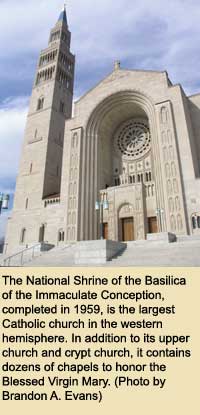2006 Vacation/Travel Supplement
Catholic roots:
Visit national shrine and papal center while touring nation’s capital
By Brandon A. Evans
 WASHINGTON, D.C.—A trip to the nation’s capital can also be a chance to see two centers of Catholicism. (See a related story)
WASHINGTON, D.C.—A trip to the nation’s capital can also be a chance to see two centers of Catholicism. (See a related story)
Nearby to one another, the nearly 50-year-old National Shrine of the Basilica of the Immaculate Conception plays host to major events while the still-new Pope John Paul II Cultural Center hosts world-famous artwork and pays tribute to the life and ministry of the late pontiff, who died on April 2, 2005.
The National Shrine is a mammoth structure that dwarfs most of the monuments in the D.C. area—6,000 people can fit inside the main church, with at least another 400 inside the crypt church on the lower level.
The basilica is 459 feet long, covers 77,500 square feet and is the largest Catholic church in the western hemisphere. It was finished in 1959.
Along the edges of the upper church, as well as in various corners in the crypt level, are dozens of smaller chapels, each devoted to the Blessed Virgin Mary in a different way.
There is a chapel for Mother of Sorrows, the Miraculous Medal, Our Mother of Africa and Our Lady of Guadalupe, to name just a few.
Among the many works of tiled mosaics are the seven domes near the main entrance, the last of which is called “The Redemption.” Artisans are still completing this mosaic.
The Web site of the basilica at www.NationalShrine.com describes one of the most noticeable features of the upper church, “the magnificent mosaic of the awesome, apocalyptic ‘Christ in Majesty,’ who comes to judge justly (depicted by the raised right brow) and with compassion (depicted by the relaxed left brow).”
Each year, the basilica hosts major Catholic gatherings, not the least of which is the annual Prayer Vigil for Life in January, which begins with a Mass on the evening before the March for Life that always packs the church beyond capacity.
 The idea for the shrine started in the early 1900s, and though the crypt church was completed by 1924, the Great Depression and World War II diverted attention from the project.
The idea for the shrine started in the early 1900s, and though the crypt church was completed by 1924, the Great Depression and World War II diverted attention from the project.
It was with, among others, the intercession and preaching of the late Bishop John Noll of Fort Wayne that the project gained steam in the 1950s, resulting in the beautiful basilica that stands today through the sacrifices of lay people all over the country. A bust of Bishop Noll is displayed outside the crypt church.
Not too far from the basilica, which sits on the campus of The Catholic University of America, is the Pope John Paul II Cultural Center.
In what could best be called a museum of types as well as a place of research, the center features items from the life of the late Polish pope as well as exhibits of artwork—sometimes exclusive displays from places such as the Vatican Museum—and opportunities for Catholics to learn more about their faith.
Lectures and consultations also occur at the center, which tries to be a place to promote the theology of the late pope.
There are five interactive galleries with varying themes: Church and papal history, faith, wonder, community and imagination. An orientation theater prepares guests for what they will see, and afterward they can either stop at the chapel to pray or relax at the café.
For more information about the papal center and upcoming exhibits, log on to www.jp2cc.org.
Either location is a great way for Catholics to root any trip to the D.C. area firmly in their faith—and both the basilica and the cultural center are perfect for family outings. †

